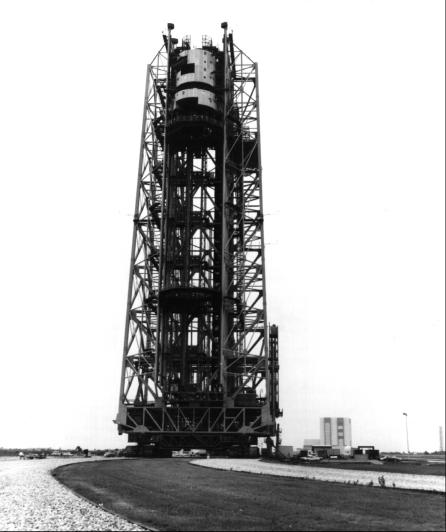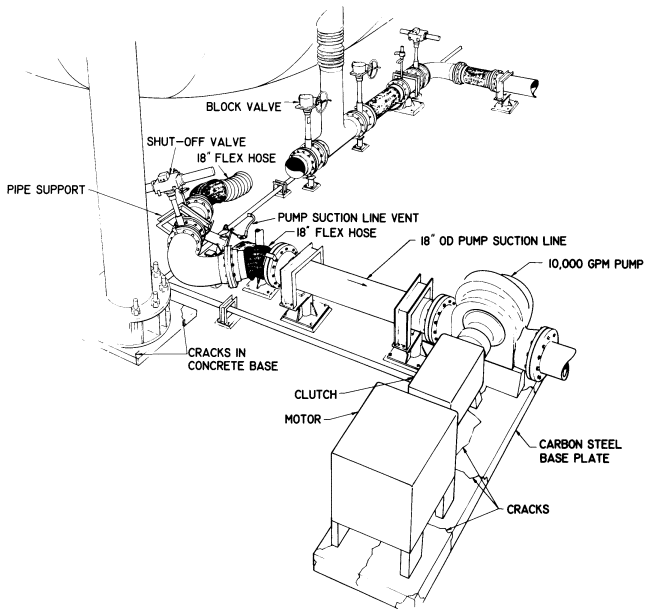
For the first time KSC missed a major milestone in June when the Site Activation Board postponed the start of the wet test for 500-F. A series of events including hurricane Alma had slowed the Wyle Company's cleaning of LOX lines. When Quality Division inspected Wyle's cleaning of the crosscountry LOX lines, a powdery residue was found in the pipes. The cleaning compound, when mixed with the local water supply, had formed a precipitate. KSC prepared new specifications for the job, directing Wyle to flush the residue from the lines with an acid solution. LOX lines on the mobile launcher, contaminated during welding operations, also required recleaning. At a board meeting on 23 June, Scheller asked Roger Enlow to expedite contractual arrangements with Spellman Engineering, the company responsible for the LOX lines on the mobile launcher. Despite Enlow's efforts, the cleaning lagged further behind schedule. On 1 July, Gruene and Scheller agreed that the wet tests could not start for another four weeks.50
KSC's program office may have underestimated the problem of keeping the cryogenic lines clean. In laying miles of pipe, workmen inevitably left debris behind. On one inspection half of a grinding wheel, broken pliers, and a glove were found in a LOX line. The use of invar for the inner pipe of the vacuum-jacketed lines further complicated matters. Invar, a steel alloy containing 36% nickel, had a very low coefficient of expansion, making it ideal for a cryogenic line; but it also rusted easily. During fabrication and installation, NASA inspectors had to watch for minute particles of dirt or moisture that might cause corrosion. When contamination was suspected, inspectors employed bore-sighting equipment to evaluate the potential corrosion. A decision did not come easily; inspectors spent a couple of weeks trying to determine if the LOX lines on the mobile launcher were rusting or were simply discolored.51
At the 7 July meeting of the Site Activation Board, Scheller announced the Apollo Program Office's plan to delay the first Saturn V mission one month. Problems with the S-II test stage at the Mississippi Test Facility had prompted General Phillips's decision. Although the directive appeared to lessen the urgency of the activation schedule, Scheller insisted that the board strive to meet the old 501 erection date. Marshall was constructing a dummy spacer as a temporary substitute for the S-II stage, and KSC would probably erect the AS-501 with the spacer to check the instrument unit.52

The crawler carrying the service structure to the pad, 21 October 1966. The assembly building is in the background, right.
During the delay caused in cleaning the LOX lines, the board scheduled the crawler's first lift of the mobile service structure for 20 July. Mobile launcher 1, with 500-F aboard, was back at pad A where the crawler had transported it after hurricane Alma's departure. The Bendix crawler crew spent two days in preliminary runs on the crawlerway and pad ramp and then carried the mobile service structure to the top of pad A for compatibility tests. Interest centered on the fit of the structure's five clamshells around the Saturn. Launch officials also tested the service structure's water deluge System.53
The RP-1 fuel system was tested in mid-July by pumping 760,000 liters of kerosene from storage tanks to 500-F. As LOX line cleaning problems persisted, the Site Activation Board reduced the number of wet tests from twelve to eight and finally to five. Spellman Corporation completed its work on the mobile launcher LOX lines in early August, and KSC rescheduled the S-IC-F LOX loading for the 15th, when failure of both LOX replenishment pumps forced a cancellation. When the launch team tried again on the 19th, it ran into much bigger trouble.54
Technicians in the launch control center began pressurizing the LOX storage vessel at 1:15 p.m. Simultaneously they opened the pneumatically operated pump suction valve, located in front of the 90 degrees elbow on the 46-centimeter suction line. This allowed a flow of LOX to cool down the 37,854-liter-per-minute pumps. What happened during the next two seconds kept several investigation boards busy for days. The gas caught in the 4.6 meters of piping between the storage vessel trap and the valve flowed out as the valve began to open (the valve was timed to open fully in ten seconds and had an eccentric pivot to aid in closing against upstream pressure). The rapid evacuation of the gas increased the velocity of the LOX flowing down from the sphere. The butterfly valve was only about 20% open when the LOX hit it with a water-hammer effect. As the liquid column backed up in the restricted passage, the pressure closed the valve disc back on its eccentric pivot. The corrugated bellows in front of the valve ruptured. A Boeing console operator in the control center secured the LOX system shortly after the accident, but he could only shut off the valves downstream from the rupture. A Boeing team at the storage vessel attempted to shut the block valve above the break manually, but the men were soon driven back by freezing LOX vapors billowing over the area. Within an hour, more than 2,700,000 liters of LOX poured out.*

Diagram of big LOX spill, 19 August 1966. A 46-cm (18-in) flexible hose beneath the storage sphere ruptured between the block valve and the shutoff valve.
The sudden decompression caused the tank's inner sphere to buckle. The outer shell retained its shape, but the collapse of a corrugated bellows, connected to the tank's relief valve, indicated that a part of the inner sphere had caved inward. When technicians removed the perlite insulation between the two tanks, they found a depression in one quadrant of the inner tank. Some of the 9.5-millimeter stainless steel plates were bent 90 degrees from their normal curvature. While KSC officials were not sure how long repairs would take, NASA headquarters announced that the accident would delay the AS-501 launch by 45 days.55
KSC faced two problems: repair of the LOX storage vessel and redesign of the system to prevent a recurrence. After draining the remaining 303,000 liters of LOX, the launch team used fans to circulate warm air through the inner tank. Following conferences with the manufacturer, KSC filled the tank with water. The stainless steel popped back into place at 0.4 kilograms per square centimeter (6 psi) and held its shape at higher pressures. KSC officials watched the operation over closed-circuit TV. While the water was draining, two engineers boarded a rubber raft to take a closer look from inside. Several days later, when engineers conducted a dye penetration test on the inner tank, no cracks were discovered. Technicians then replaced the perlite insulation between the inner and outer tanks. All damaged equipment had been replaced by 14 September. Meanwhile, KSC and Boeing engineers, with advice from consultant Peter C. Vander Arend, modified the system to fill the LOX line from the storage vessel to the pneumatically operated valve gradually, prior to chilling the pump. KSC replaced the flex hose where the break had occurred with hard pipe and substituted a pneumatic valve for the manual block valve.56 The new circulation and precooling system was installed by mid-September, and the second loading of LOX into S- IC-F went off without incident on 20 September. The remaining tests followed in rapid succession. With all of the AS-501 stages at the Cape (the S-II spacer in place of the live second stage), KSC officials were anxious to get on with the real show. 500-F came down in mid-October, ending seven months of valuable service.57
*The closed-circuit TV proved its worth during this accident. When Debus heard about the rupture, he rushed to the pad area, only to find the view obscured by the LOX vapor. When he returned to the headquarters building, the conference room screen had good pictures. A more detailed account of the accident and subsequent repairs appears in W. I. Moore and R. J. Arnold, "Failure of Apollo Saturn V Liquid Oxygen Loading System," Advances in Cryogenic Engineering, vol. 13.


